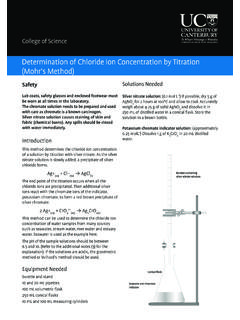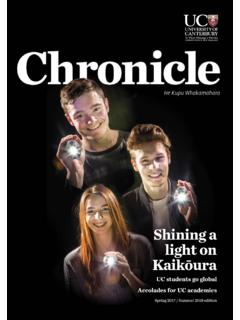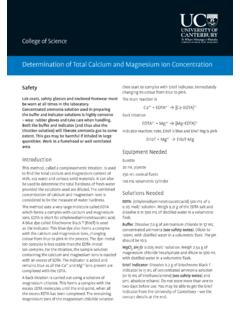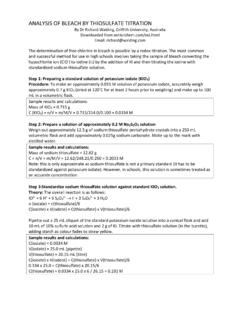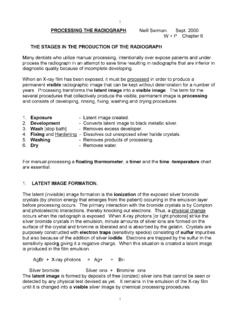Transcription of Determination of Ethanol Concentration in Aqueous Solutions
1 College of Science1 Determination of Ethanol Concentration in Aqueous SolutionsIntroductionThis method uses a redox titration to find the Concentration of Ethanol in an Aqueous solution. The Ethanol is oxidised to ethanoic acid by reacting it with an excess of potassium dichromate in acid. 2 Cr2O72 + 16 H+ + 3 C2H5OH 4 Cr3+ + 11 H2O + 3 CH3 COOHThe amount of unreacted dichromate is then determined by adding potassium iodide solution which is also oxidised by the potassium dichromate forming iodine. Cr2O72 + 14 H+ + 6 I 2 Cr3+ + 3 I2 + 7 H2 OThe iodine is then titrated with a standard solution of sodium thiosulfate and the titration results are used to calculate the Ethanol content of the original solution. 2 S2O32 + I2 S4O62 + 2 I Because alcoholic beverages such as wine or beer contain other oxidisable substances that could interfere with the titration, the dichromate solution is placed in Rubber stopperGlass hook250 mL Conical flask (wide mouth)Sample holderAcid dichromate solutiona flask and the alcoholic beverage sample is suspended in a small container above it (see diagram).
2 The water and Ethanol slowly evaporate and as the Ethanol comes in contact with the dichromate it first dissolves, and is then oxidised. More Ethanol evaporates until eventually all the Ethanol from the beverage has left the sample and reacted with the dichromate. Since this transfer takes time, it is necessary to leave the flask with the suspended sample in a warm place Needed 250 mL conical flasks with rubber stoppersburette5 mL beakers or small glass vialsbeer or wine sample10 mL and 1 mL pipettesincubator (optional) Solutions NeededAcid dichromate solution: ( molL-1 in molL-1 sulfuric acid) (see safety notes). Add 125 mL of water to a 500 mL conical flask. Carefully add 70 mL of concentrated sulfuric acid with constant swirling. Cool flask under cold water tap and add g of potassium dichromate. Dilute to 250 mL with distilled water. Starch indicator solution: ( solution) Dissolve g of soluble starch in 100 mL of recently boiled water.
3 Stir until thiosulfate solution: ( ). Add g of to a 1L volumetric flask, dissolve in distilled water and dilute up to the iodide solution: ( ) Dissolve 5 g of KI in 25 mL of coats, safety glasses and enclosed footwear must be worn at all times in the laboratory. The acid dichromate solution needs to be prepared with care. Any concentrated acid spills must be cleaned up by very carefully diluting with water before wiping up. Take care to put the water in the flask first before adding the acid, and add the acid slowly with constant swirling. The flask will get quite method uses a redox titration to find the Concentration of Ethanol in an Aqueous solution. The Ethanol is oxidised to ethanoic acid by reacting it with an excess of potassium dichromate in Cr2 O72 + 16 H+ + 3 C2H5OH 4 Cr3+ + 11 H2O + 3 CH3 COOHThe amount of unreacted dichromate is then determined by adding potassium iodide solution which is also oxidised by the potassium dichromate forming + 14 H+ + 6 I 2 Cr3+ + 3 I2 + 7 H2 OThe iodine is then titrated with a standard solution of sodium thiosulfate and the titration results are used to calculate the Ethanol content of the original S2O32 + I2 S4O62 + 2 I Because alcoholic beverages such as wine or beer contain other oxidisable substances that could interfere with the titration, the dichromate solution is placed in a flask and the alcoholic beverage sample is suspended in a small container above it (see diagram).
4 The water and Ethanol slowly evaporate and as the Ethanol comes in contact with the dichromate it first dissolves, and is then oxidised. More Ethanol evaporates until eventually all the Ethanol from the beverage has left the sample and reacted with the dichromate. Since this transfer takes time, it is necessary to leave the flask with the suspended sample in a warm place Needed250 mL conical flasks with rubber stoppersburette5 mL beakers or small glass vialsbeer or wine sample10 mL and 1 mL pipettesincubator (optional) Determination of Ethanol Concentration in Aqueous Solutions2 MethodSample Preparation1. Dilute beer samples 1:20 (10 mL in 200 mL) with distilled Dilute wine samples 1:50 (20 mL in 1000 mL) with distilled (described for one beverage) 1. Transfer 10 mL of the acid dichromate solution (see safety notes) to a 250 mL conical flask with matching rubber Pipette 1 mL of the diluted beverage sample into the sample holder.
5 This can be a 5mL beaker or glass vial. Prepare three samples of the beverage as the entire contents of the flask are used in the Suspend the sample holder over the dichromate solution and hold in place with the rubber stopper (see figure 1).4. Store the flask overnight at 25 30 C (an incubator is ideal).5. Next morning allow the flask to come to room temperature, then loosen the stopper carefully and remove and discard the sample Rinse the walls of the flask with distilled water, then add about 100 mL of distilled water and 1 mL of potassium iodide solution. Swirl to Prepare 3 blank titrations by adding 10 mL of acid dichromate solution to a conical flask, adding 100 mL of water and 1 mL of potassium iodide solution and swirling to Fill a burette with sodium thiosulfate solution and titrate each flask with sodium thiosulfate . When the brown iodine colour fades to yellow (figure 2), add 1 mL of starch solution and keep titrating until the blue colour disappears (figures 3-5).
6 Titrate the blank flasks first, and repeat until concordant results are obtained (titres agreeing to within mL). Then titrate each of the alcohol samples. If the three samples of the beverage do not give concordant results, further samples will need to be prepared. Figure 1 Experimental setup for oxidation of Ethanol . Conical flask contains yellow acid dichromate solution and is sealed with rubber stopper. Small beaker containing beverage sample is suspended above from hook in rubber 2 Titration of the iodine formed. The left flask shows the brown-coloured solution resulting from the formation of iodine. The right flask shows how the brown colour fades to pale yellow as the iodine is titrated with thiosulfate (this is the stage at which starch solution should be added).Figure 3 Upon addition of starch the solution takes on a blue-black colour due to the formation of a starch-iodine 4 As more thiosulfate is added and we near the titration endpoint, the blue-black colour from the starch-iodine complex 5 The endpoint of the titration is reached when just enough thiosulfate is added to react with all the iodine present and the solution becomes Preparation1.
7 Dilute beer samples 1:20 (10 mL in 200 mL) with distilled Dilute wine samples 1:50 (20 mL in 1000 mL) with distilled (described for one beverage) 1. Transfer 10 mL of the acid dichromate solution (see safety notes) to a 250 mL conical flask with matching rubber Pipette 1 mL of the diluted beverage sample into the sample holder. This can be a 5mL beaker or glass vial. Prepare three samples of the beverage as the entire contents of the flask are used in the Suspend the sample holder over the dichromate solution and hold in place with the rubber stopper (see figure 1).4. Store the flask overnight at 25 30 C (an incubator is ideal).5. Next morning allow the flask to come to room temperature, then loosen the stopper carefully and remove and discard the sample Rinse the walls of the flask with distilled water, then add about 100 mL of distilled water and 1 mL of potassium iodide solution. Swirl to Prepare 3 blank titrations by adding 10 mL of acid dichromate solution to a conical flask, adding 100 mL of water and 1 mL of potassium iodide solution and swirling to Fill a burette with sodium thiosulfate solution and titrate each flask with sodium thiosulfate .
8 When the brown iodine colour fades to yellow (figure 2), add 1 mL of starch solution and keep titrating until the blue colour disappears (figures 3-5). Titrate the blank flasks first, and repeat until concordant results are obtained (titres agreeing to within mL). Then titrate each of the alcohol samples. If the three samples of the beverage do not give concordant results, further samples will need to be prepared. Figure 1 Experimental setup for oxidation of Ethanol . Conical flask contains yellow acid dichromate solution and is sealed with rubber stopper. Small beaker containing beverage sample is suspended above from hook in rubber 2 Titration of the iodine formed. The left flask shows the brown-coloured solution resulting from the formation of iodine. The right flask shows how the brown colour fades to pale yellow as the iodine is titrated with thiosulfate (this is the stage at which starch solution should be added).
9 Figure 3 Upon addition of starch the solution takes on a blue-black colour due to the formation of a starch-iodine 4 As more thiosulfate is added and we near the titration endpoint, the blue-black colour from the starch-iodine complex 5 The endpoint of the titration is reached when just enough thiosulfate is added to react with all the iodine present and the solution becomes Preparation1. Dilute beer samples 1:20 (10 mL in 200 mL) with distilled Dilute wine samples 1:50 (20 mL in 1000 mL) with distilled (described for one beverage) 1. Transfer 10 mL of the acid dichromate solution (see safety notes) to a 250 mL conical flask with matching rubber Pipette 1 mL of the diluted beverage sample into the sample holder. This can be a 5mL beaker or glass vial. Prepare three samples of the beverage as the entire contents of the flask are used in the Suspend the sample holder over the dichromate solution and hold in place with the rubber stopper (see figure 1).
10 4. Store the flask overnight at 25 30 C (an incubator is ideal).5. Next morning allow the flask to come to room temperature, then loosen the stopper carefully and remove and discard the sample Rinse the walls of the flask with distilled water, then add about 100 mL of distilled water and 1 mL of potassium iodide solution. Swirl to Prepare 3 blank titrations by adding 10 mL of acid dichromate solution to a conical flask, adding 100 mL of water and 1 mL of potassium iodide solution and swirling to Fill a burette with sodium thiosulfate solution and titrate each flask with sodium thiosulfate . When the brown iodine colour fades to yellow (figure 2), add 1 mL of starch solution and keep titrating until the blue colour disappears (figures 3-5). Titrate the blank flasks first, and repeat until concordant results are obtained (titres agreeing to within mL). Then titrate each of the alcohol samples. If the three samples of the beverage do not give concordant results, further samples will need to be prepared.

